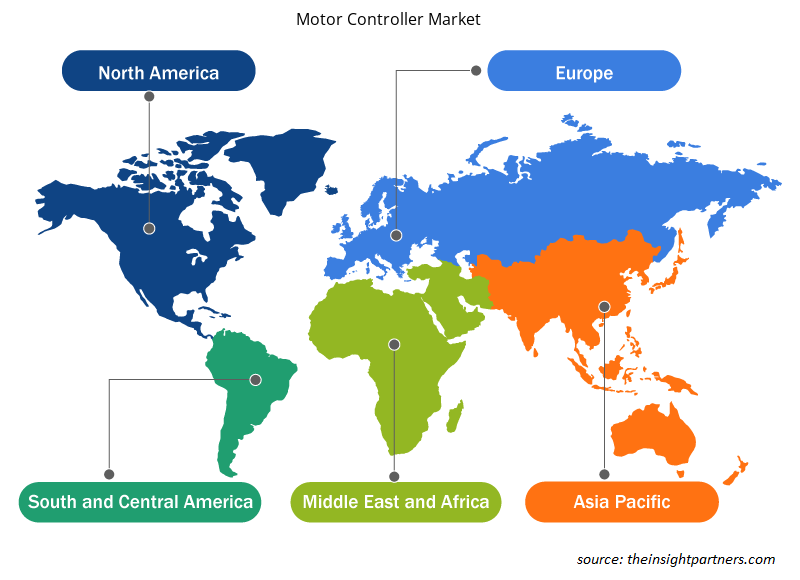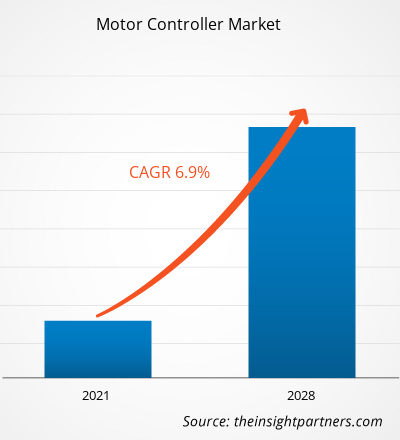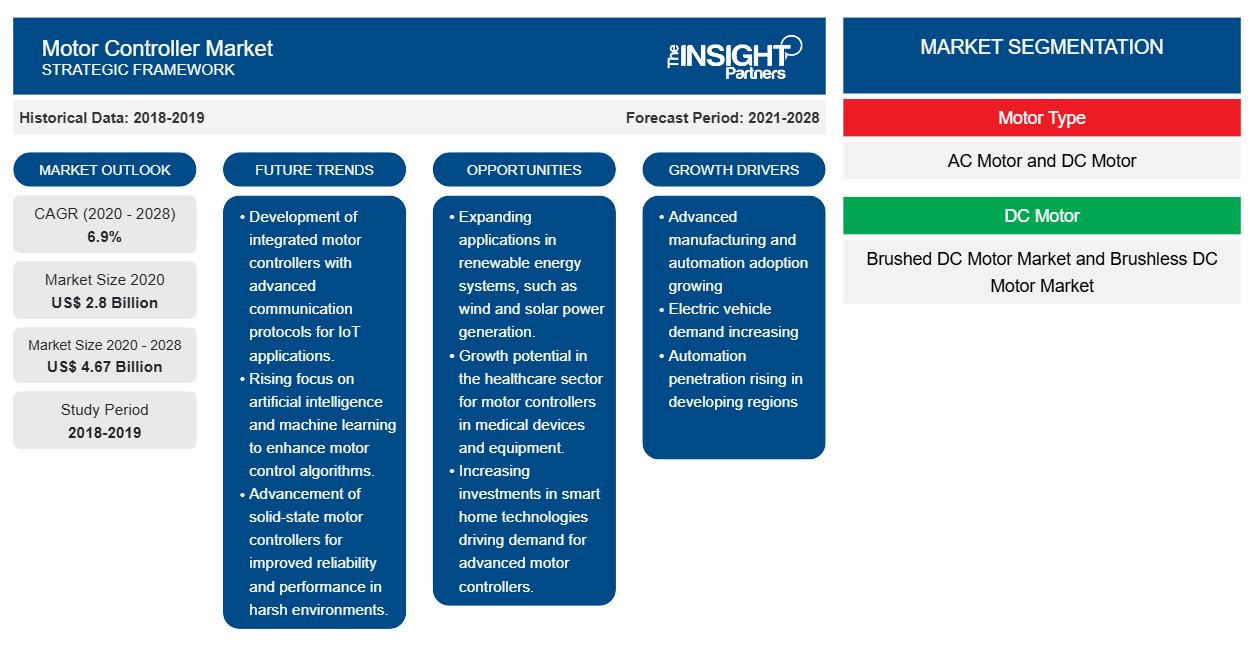El mercado de controladores de motores se valoró en US$ 2.800,7 millones en 2020 y se proyecta que alcance los US$ 4.674,1 millones en 2028; se espera que crezca a una CAGR del 6,9% entre 2021 y 2028.
El mercado global de controladores de motores está segmentado en cinco regiones principales: América del Norte, Europa, APAC, MEA y SAM. Uno de los factores clave que impulsa el crecimiento del mercado de controladores de motores es la creciente adopción de procesos avanzados y automatizados en el sector manufacturero, junto con la creciente penetración de la automatización en las regiones en desarrollo. Las industrias de todo el mundo han experimentado rápidos desarrollos en términos de fabricación y tecnología. En este curso, los fabricantes de automóviles están actualizando los sistemas, agregando capacidades de inspección y conexión en red y aprovechando las tecnologías de integración para producir un producto mejor y más barato en menos tiempo. Existe una gran demanda de motores de accionamiento directo y servo en electrodomésticos, aplicaciones de movilidad eléctrica y vehículos guiados automáticamente (AGV), que se espera que desempeñen un papel importante en el impulso de la demanda de productos. Además, se espera que la creciente demanda de vehículos eléctricos y la implementación de estrictas regulaciones gubernamentales sobre el uso de productos energéticamente eficientes impulsen el crecimiento del mercado durante el período de pronóstico. Además, los dispositivos controladores de motor ayudan a mejorar la eficiencia de los procesos de producción y las instalaciones de fabricación en la industria automotriz, y los países en desarrollo como India, China, Brasil y Taiwán están adoptando sistemas de controlador de motor avanzados en sus industrias manufactureras para producir productos energéticamente eficientes.
Impacto de la pandemia de COVID-19 en el mercado de controladores de motores
La pandemia de COVID-19 sigue limitando el crecimiento de las industrias manufactureras en general debido a la interrupción de las actividades de la cadena de suministro y el cierre del comercio internacional en varios países. Como resultado, varios países han sido testigos de una caída en la demanda de productos de automatización como control de ascensores, equipos de ensamblaje/empaquetado, robótica y sistemas de control de vuelo, lo que posteriormente ha afectado negativamente el desempeño de la industria de controladores de motores. Por lo tanto, se proyecta que el mercado se recupere en los próximos meses.
Personalice este informe según sus necesidades
Obtendrá personalización en cualquier informe, sin cargo, incluidas partes de este informe o análisis a nivel de país, paquete de datos de Excel, así como también grandes ofertas y descuentos para empresas emergentes y universidades.
- Obtenga las principales tendencias clave del mercado de este informe.Esta muestra GRATUITA incluirá análisis de datos, desde tendencias del mercado hasta estimaciones y pronósticos.
Perspectivas de mercado: mercado de controladores de motores
El aumento de las inversiones en vehículos eléctricos está impulsando la demanda de controladores de motor. Muchas empresas automotrices están a punto de comenzar la fabricación a gran escala de vehículos eléctricos. En 2019, Ford Motor Co. anunció su ritmo de producción de motores eléctricos en su planta Van Dyke Transmission en los suburbios de Detroit. La empresa planea gastar aproximadamente USD 11.5 mil millones en vehículos eléctricos e híbridos hasta 2022; como parte de esto, se espera que la empresa entregue 40 vehículos electrificados, incluidos 16 completamente eléctricos. Estas inversiones en curso en el desarrollo y la producción de vehículos eléctricos están impulsando la demanda de dispositivos avanzados de control de motor.
Información sobre segmentos de tipos de motores
Los dispositivos de control de motores coordinan principalmente de manera predeterminada el rendimiento del motor eléctrico. Un controlador de motor incluye un medio manual o automático para arrancar y detener el motor, seleccionar la rotación hacia adelante o hacia atrás, seleccionar y regular la velocidad, regular o limitar el par y proteger contra sobrecargas y fallas eléctricas. Según el tipo de motor, el mercado de controladores de motores se divide en motores de CA y motores de CC.
Perspectivas del segmento de motores de corriente continua
En cuanto a los motores de CC, el segmento de mercado de motores de CC sin escobillas dominó el mercado global de controladores de motores con una participación del 70,39 % en 2020. Además, se prevé que el mismo segmento continúe su dominio durante el período de pronóstico para representar el 70,19 % de la participación de mercado para fines de 2028.
Información sobre segmentos del rango de potencia de salida
Según el rango de potencia de salida, el segmento de 0,6 a 1,0 HP dominó el mercado global de controladores de motores con una participación del 40,94 % en 2020. Además, se prevé que el mismo segmento continúe su dominio durante el período de pronóstico para representar el 42,21 % de la participación de mercado para fines de 2028.
Información sobre segmentos de tipo de voltaje
Según el tipo de voltaje, el segmento de motores por debajo de 1 kV dominó el mercado global de controladores de motores con una participación del 51,74 % en 2020. Además, se anticipa que el mismo segmento continuará su dominio durante el período de pronóstico para representar el 54,57 % de la participación de mercado global para fines de 2028.
Información sobre segmentos de usuarios finales
Por usuario final, el segmento industrial dominó el mercado global de controladores de motores con una participación del 38,66 % en 2020. Además, se anticipa que el mismo segmento continuará dominando durante el período de pronóstico para representar el 35,01 % de la participación de mercado para fines de 2028.
Los actores del mercado se centran en innovaciones y desarrollos de nuevos productos integrando tecnologías y características avanzadas en sus productos para competir con los competidores.
Perspectivas regionales del mercado de controladores de motores
Los analistas de Insight Partners explicaron en detalle las tendencias y los factores regionales que influyen en el mercado de controladores de motores durante el período de pronóstico. Esta sección también analiza los segmentos y la geografía del mercado de controladores de motores en América del Norte, Europa, Asia Pacífico, Oriente Medio y África, y América del Sur y Central.

- Obtenga los datos regionales específicos para el mercado de controladores de motores
Alcance del informe de mercado de controladores de motor
| Atributo del informe | Detalles |
|---|---|
| Tamaño del mercado en 2020 | 2.800 millones de dólares estadounidenses |
| Tamaño del mercado en 2028 | US$ 4.67 mil millones |
| Tasa de crecimiento anual compuesta (CAGR) global (2020-2028) | 6,9% |
| Datos históricos | 2018-2019 |
| Período de pronóstico | 2021-2028 |
| Segmentos cubiertos | Por tipo de motor
|
| Regiones y países cubiertos | América del norte
|
| Líderes del mercado y perfiles de empresas clave |
|
Densidad de actores del mercado de controladores de motores: comprensión de su impacto en la dinámica empresarial
El mercado de controladores de motores está creciendo rápidamente, impulsado por la creciente demanda de los usuarios finales debido a factores como la evolución de las preferencias de los consumidores, los avances tecnológicos y una mayor conciencia de los beneficios del producto. A medida que aumenta la demanda, las empresas amplían sus ofertas, innovan para satisfacer las necesidades de los consumidores y aprovechan las tendencias emergentes, lo que impulsa aún más el crecimiento del mercado.
La densidad de actores del mercado se refiere a la distribución de las empresas o firmas que operan dentro de un mercado o industria en particular. Indica cuántos competidores (actores del mercado) están presentes en un espacio de mercado determinado en relación con su tamaño o valor total de mercado.
Las principales empresas que operan en el mercado de controladores de motores son:
- Compañía: ABB Ltd.
- Compañía AMETEK Inc.
- Corporación Eaton plc
- Compañía General Electric
- AUTOMATIZACIÓN ANAHEIM, INC.
Descargo de responsabilidad : Las empresas enumeradas anteriormente no están clasificadas en ningún orden particular.

- Obtenga una descripción general de los principales actores clave del mercado de controladores de motores
El mercado global de controladores de motores se ha segmentado de la siguiente manera:
Mercado de controladores de motores: por tipo de motor
- Motor de CA
- Motor de corriente continua
Mercado de controladores de motores: por motor de CC
- Mercado de motores de corriente continua con escobillas
- Mercado de motores de corriente continua sin escobillas
Mercado de controladores de motores: por rango de potencia de salida
- Por debajo de 0,5 HP
- 0,6–1,0 CV
- 1,0–3,0 CV
- Más de 3,0 HP
Mercado de controladores de motores: por tipo de voltaje
- Motores por debajo de 1 kV
- Motores de 1 kV a 6,6 kV
- Más de 6,6 kV
Mercado de controladores de motores por usuario final
- Industrial
- Comercial
- Residencial
- Transporte
- Agricultura
Mercado de controladores de motores por región
América del norte
- A NOSOTROS
- Canadá
- México
Europa
- Francia
- Alemania
- Italia
- Reino Unido
- Rusia
- Resto de Europa
Asia Pacífico (APAC)
- Porcelana
- India
- Corea del Sur
- Japón
- Australia
- Resto de APAC
Oriente Medio y África (MEA)
- Sudáfrica
- Arabia Saudita
- Emiratos Árabes Unidos
- Resto de MEA
América del Sur (SAM)
- Brasil
- Argentina
- Resto de SAM
Mercado de controladores de motores: perfiles de empresas
- Compañía: ABB Ltd.
- Compañía AMETEK Inc.
- Corporación Eaton plc
- Compañía General Electric
- AUTOMATIZACIÓN ANAHEIM, INC.
- SISTEMAS DE ARCO INC
- ErieTec Inc
- Tecnología Microchip Inc.
- Corporación Nidec
- Corporación Parker-Hannifin
- Análisis histórico (2 años), año base, pronóstico (7 años) con CAGR
- Análisis PEST y FODA
- Tamaño del mercado, valor/volumen: global, regional y nacional
- Industria y panorama competitivo
- Conjunto de datos de Excel
Informes recientes
Informes relacionados
Testimonios
Razón para comprar
- Toma de decisiones informada
- Comprensión de la dinámica del mercado
- Análisis competitivo
- Información sobre clientes
- Pronósticos del mercado
- Mitigación de riesgos
- Planificación estratégica
- Justificación de la inversión
- Identificación de mercados emergentes
- Mejora de las estrategias de marketing
- Impulso de la eficiencia operativa
- Alineación con las tendencias regulatorias























 Obtenga una muestra gratuita para - Mercado de controladores de motores
Obtenga una muestra gratuita para - Mercado de controladores de motores